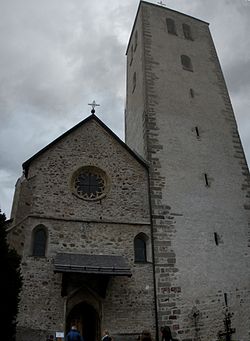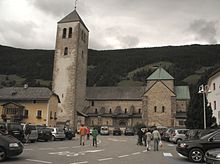- Innichen Abbey
-
The Abbey of Innichen (German: Stiftskirche Innichen) is a religious complex in Innichen in South Tyrol in northern Italy. Founded in the 8th century and rebuilt in the 12th–13th centuries, it is considered the most important Romanesque building in Tyrol and the Eastern Alps[1][2] and, in is home to a 13th century sculpture and a fresco cycle from the same age in the dome.
Contents
History
The original nucleus of the complex was founded in 769, when Tassilo III, duke of Bavaria gave to abbot Atto von Scharnitz some lands going from the current Monguelf to Abfaltersbach, provided that a Benedictine convent would be founded here, to convert the Pagan Slavs who had established in the area.[3] Of this original construction, however, no certain traces have been found.
The church was entirely rebuilt from 1140[1]: of this edifice today the external walls, the piers, the apses and the crypt remain. A second reconstruction was carried out from around 1240,[1] when the vaults of the crypt and the nave, the transept and the dome at the crossing were added, including the frescoes with the History of Creation. Once finished, the church was consecrated to St. Candid and St. Corbinianus, patron saint of the Archdiocese of Munich and Freising, to which the abbey belonged at the time. The large bell tower was built later, from 1323 to 1326.
The edifice did not undergo any substantial modification. In 1969[1] a restoration was held, removing the few minor additions it had received during the centuries (especially in Baroque times), in particular re-discovering the crypt's frescoes, which had been covered with a layer of plaster.
Description
Exterior
The church has a simple façade, in crude stone blocks. Over the central portal are two small mullioned windows, surmounted by a small frame dividing the façade in two and a rose window. On the left is the massive bell tower, also in stone, with a square plane: each of the sides has a row of thin mullioned windows, except for the top floors, which have a larger single- and double- mullioned windows. The top is pyramidal in shape.
The rear area is more complex. The crossing is the background of a descending sequence of blocks, started by the presbytery, and followed by the nave's apse, the roofs of the aisles' apses and finally the apses themselves. Another block on the left is the sacristy. The apses' exterior is decorated by Lombard bands.
On the right side are a pilaster-shaped tabernacle, frescoed in the 15th century, and the Museum of the Collegiate.[1]
Interior
The interior has a nave and two aisles, the latter smaller in height, with a transept, a presbytery and three aisles. At the crossing is a crypt. This houses a 13th century wooden sculpture portraying on the two patron saints of the church.
The dome is frescoed with the Stories of Creation, painted in the 13th century.
References
- ^ a b c d e "Romanico – La Collegiata di San Candido". Page at Suedtirol.info. http://www.suedtirol.info/Alto_Adige/architettura_in_dettaglio/D-1207-it-Romanico_La_Collegiata_di_San_Candido.html. Retrieved 4 December 2010.
- ^ Guide di Touring Club Italiano: Piccole città, borghi e villaggi. Milan 2006
- ^ History of Innichen at the municipality's webpage
Sources
- Kühebacher, Egon (1993) (in German). Kirche und Museum des Stiftes Innichen. Bolzano: Athesia. ISBN 978-88-7014-721-6.
Coordinates: 46°43′58″N 12°16′58″E / 46.73278°N 12.28278°E
Categories:- Romanesque architecture in Italy
- Monasteries in South Tyrol
- Benedictine monasteries in Italy
- 12th-century architecture
Wikimedia Foundation. 2010.




